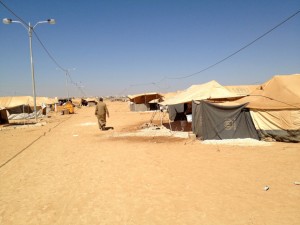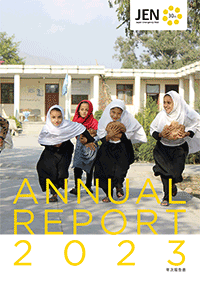An interview with a mom living in the Syrian refugee camp
She, having fled to the Zattari camp by night over two days with her six children and husband, said “I have six-month-old baby, but I don’t have enough baby formula to feed my baby.” Amid a stressful situation of the camp, it’s a heartwarming time with children like this that allows us to forget all about unpleasant things for a time in the camp.
Jordanian short autumn is now coming and so it’s getting so colder every day that you can’t go without outer wear. In right of this situation, it’s feared the poor sanitary conditions in the camp will help spread flu or infectious diseases among children in days ahead. She said “I don’t have enough children’s clothes.
I feel gloomy about the future of ours.”There are so many refugees like her who got to the camp with only the barest necessities and don’t even have enough clothing or living goods.
Activities initiated by international agencies are improving access to safe drinking water and baby formula in the camp. However, refugees still suffer from shortage of commodities such as clothing, sanitary goods like soaps and detergents, baby formula and diapers.
That creates frustrations that are growing daily among refugees.
The latest news of aid activities for Syrian refugees
Up to 81,456 Syrian refugees1,, have fled to Jordan, the largest in neighboring countries of Syria and most of them are staying in northern Jordan near border with Syria. The government of Jordan has intention to open a refugee camp at Zattari that can accommodate (house) 120,000 refugees in order to put refugees together. It’s also improving the infrastructure of the camp along with U.N. agencies and other organizations.
26,000 refugees (as of September 6 2) are evacuating in the Zattari camp and thirty-seven percent of them are under the age of twelve. 2,000 to 3,000 Refugees flee into Jordan by crossing the border from Syria every day. The refugees in the camp complain about lack of electricity, medical assistance and food as well as the camp’s own regional, harsh environment.
Although U.N. agencies are working on improving hard living conditions of refugees in the camp set up in the middle of the desert, where harsh environment such as dust, extreme heat and hot wind force them to live in an exceptionally difficult conditions.
Especially, sand and dust whipped up by the strong wind are so thick that they prevent you from seeing even a few meters ahead and cover the camp all over. That not only makes refugees feel uncomfortable (cause hardship for refugees) but also could seriously affect their health
A Syrian woman living in the camp complained that the laundry makes no sense because clothes are covered with sand dust in less than five minutes after washing. She told us about her hash living conditions, and that a doctor offering medical services in the camp warns against the spread of respiratory inffection among young children.
Before long Jordan will face with a cold season with heavy rainfall, and so it’s feared that the camp will be stuck in deep mud and infectious diseases will spread across the camp. Syria’s political situation remains unpredictable. It’s also unpredictable to see how long refugees have to evacuate in the uncomfortable refugee camp and when they can return to Syria. JEN supports the livelihood of refugees in the camp through aid activities for them, hoping they will be allowed to return to their homes as soon as possible.
Annotation
1. According to the government of Jordan, there are now more than 150,000 displaced Syrians who are registered or are awaiting registration with UNHCR in Jordan (UNHCR’s registration figures of refugees as of September 7).
2. Same as above
JEN initiates emergency aid activities for Syrian refugees
JEN’s emergency aid for Syrian refugees: Please contribute to help Syrian refugees.
DONATE HERE.)
To allow providing quick aid, your support is necessary. Thank you for your donation!
The Zataari refugee camp in Jordan set up in a vast desert is on the border with Syria. The camp accommodates about 23,400 people (as of August 26, according to a survey by UNHCR), almost half of them are under the age of eighteen. Water sanitation facilities like toilets, showers have been set up in the camp but diarrhea went around among children for a while, a poor sanitatry condition was thought to be the possible cause of the diarrhea. The next to fear is respiratory affection due to fugitive dust in the desert. (There is also fear that children may suffer from respiratory affections.) Both from JEN’s survey of refugees’ needs in the camp and its experiences on emergency aid so far, JEN identified the need to improve (necessity of improving) children’s sanitary conditions. After having talks with U.N. agencies and other organizations, JEN decided to give hygiene education to refugees especially children as an emergency aid to prevent the spread of water-related diarrhea and infectious diseases.
In parallel with the emergency aid, JEN will continue to monitor situations closely in neighboring countries and identify necessity for aid in other areas as needed including aid for refugees to overwinter.
【A sight of Zataari refugee camp】

Activities in Jordan to date
JEN started providing emergency medical care at a refugee camp at Iraq-Jordan border for people who had fled to the border in response to the strike against Iraq by the U.S. and British forces in March 2003. Since opening an office at the capital city of Amman, Jordan in August 2004, JEN has been providing aid in neighboring Iraq from the remotely-situated office. Until now, JEN has worked on providing children who tend to be socially vulnerable with aid such as repairing school buildings and offering health education at schools in poverty areas of Baghdad, provinces of al-’Anbār, Bābil, Kerkûk and Diyālā. With the deterioration of the political situation in Syria and rising refugees, JEN surveyed what is needed in Iraq and Jordan. As a result of the survey, JEN first initiates aid activities in Jordan where JEN has its office.

![Jordan [Syrian refugees]](/en/project/images/mainimg_project_jordan.jpg)



